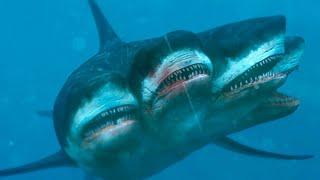TOP 10 Strangest SHARK Species
Description
TOP 10 Strangest SHARK Species...
100M is the #1 place for all your heart warming stories about amazing people that will inspire you everyday. Make sure to subscribe and never miss a single video!
#viral #amazing #100M #animals
Top 10 Strangest SHARK Species
More often, we associated the name “shark” with the great whites. This is only natural as these are the most common sharks we encounter. But they aren’t the only ones in the shark kingdom.
There are over 500 shark species, some of which have just been discovered as recently as 10 years ago. Most of these haven’t been studied in detail but some tidbits of information are available.
So here we are – 10 of these majestic beasts that are just as strange as they’re fascinating.
#10 Basking Shark
A basking shark usually averages 8 meters in length but some can grow to 12 meters making it the second-largest shark in the world after the mighty whale shark.
Just like the whale shark, it’s also a filter feeder swimming at considerably slow speeds to filter out plankton from the ocean water. Of course, the mouth is a big part of this feeding process so it remains open most of the time.
When wide open, the mouth measures about a meter wide which ensures the shark filters as much water as possible.
So despite their intimidating size, basking sharks aren’t threatening humans. They’re gentle giants, so to speak. That immense size also means they’re pretty much safe from some of the most vicious marine predators like killer whales and great white sharks.
Generally, basking sharks are solitary but get together once in a while for group fun. During summer, for instance, they can be found in groups of up to 100 in plankton-dense waters feeding and engaging in social behavior.
#9 Saw Shark
Saw shark actually refers to a family of sharks rather than just a single individual. The group is made up of 10 species but they all have one feature in common – a conspicuous snout shaped in the form of a saw.
The snout is fashioned with teeth on both sides making it just the perfect weapon for hunting. As seafloor dwellers, sea sharks use their elongated snouts to dig out prey from the ocean sand and smack them sideways before gorging themselves.
To detect prey, these sharks use specialized sensory organs on their snout that pick out the electric field created by potential prey.
This is the same way the sawfish use their long beaks. It might seem as though these two are similar but there exist a few notable differences, for instance, sawfish aren’t sharks and they tend to be larger than saw sharks.
While an average sawfish is 7 meters long, most saw sharks average just below 2 meters.
Usually, these sharks stay at depths of between 40 and 100 meters but have been observed going deeper to about 900 meters in tropical regions.
#8 Megamouth Shark
The megamouth shark is so named because of its huge bathtub-like mouth. According to earlier observations, the mouth can open up to 1.3 meters wide.
They’re extremely rare beasts that, according to the Business Insider, just about 60 individuals exist. Roughly 100 of them have been observed since the shark species was first discovered in 1976. Sadly, most of these were found dead.
While they’re rarely observed these days, scientists believe that these beasts live in all the four world oceans in the deepest waters. But the depths they stay at vary with the time of the day.
During the daytime, they reside at depths of between 120 to 200 meters but once the night comes knocking, they ascend to depths of about 12 -25 meters.
This is a pretty common behavior among aquatic animals that feed on plankton. They use this vertical migration to track the movement of plankton. And that means these sharks are filter feeders depending solely on this plankton as a food source.
Megamouths tend to be large with an average length of 5 meters but outliers do exist. For instance, the longest recorded length is 7.6 meters. The weight on the other hand can go as much as 1.2 tons on the higher side.
#7 Horn Shark
Horn sharks are known for their blunt head and a brown to gray coloration punctuated by small dark spots. They’re endemic to the western coast of North America running from California to the Gulf of California.
Just how deep they reside is largely dependent on their age. Adult horn sharks are usually found in shallower waters while the juveniles stay a bit deeper in the sea.
In these habitats, they are solitary for a larger part and move very slowly on the seafloor. Unique about these sharks is that they usually have specific shelters where they spend their time.
They’re grounded at these points during the day when they take a rest after a night of hunting. But even if they go looking for prey, they never swim too far from their homes. They form a sort of territory that they restrict themselves to for up to 10 years.





















Comments